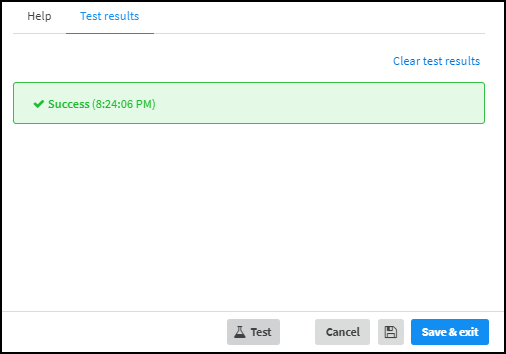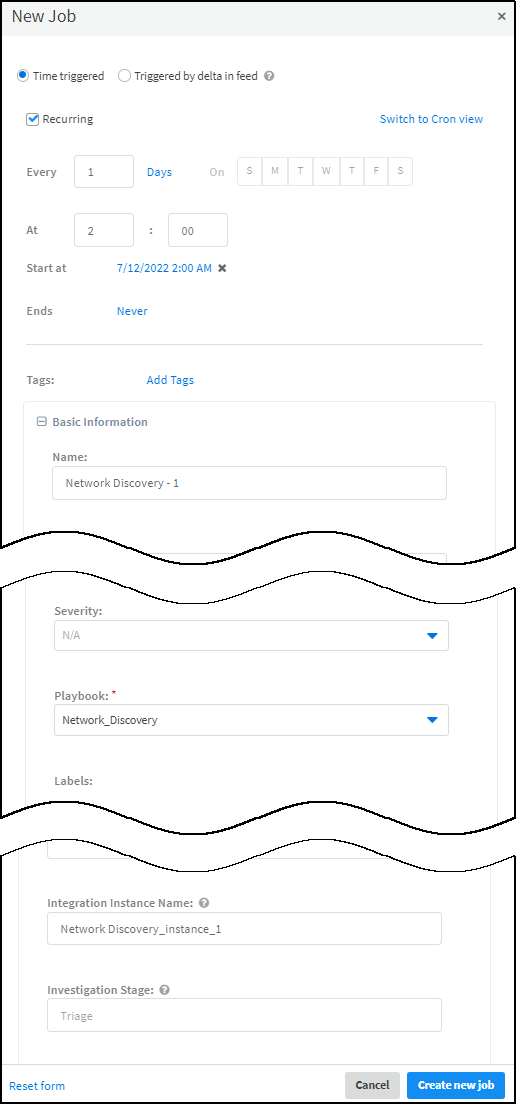IoT Security
Set up IoT Security and Cortex XSOAR for Network Discovery
Table of Contents
Expand All
|
Collapse All
IoT Security Docs
Set up IoT Security and Cortex XSOAR for Network Discovery
Set up IoT Security and Cortex XSOAR to discover network
data by querying switches through SNMP.
| Where Can I Use This? | What Do I Need? |
|---|---|
|
One of the following Cortex XSOAR setups:
|
To set up IoT Security to integrate through
Cortex XSOAR with network switches, you must add a Cortex XSOAR
engine to your network.
You must also configure one or more
network discovery instances in XSOAR, creating one instance for
each entry switch you use—typically one per site or per network
segment within a single site. To do this, you need the IP address
of the entry switches and the SNMP community string for read-only
access.
Cortex XSOAR Engine Installation
The Cortex XSOAR engine initiates connections
to switches and to the Cortex cloud and provides the means through which
they communicate with each other. Although it's possible to install
an XSOAR engine on machines running Windows, macOS, and Linux operating
systems, only an engine on a Linux machine supports IoT Security
integrations. For more information about operating system and hardware
requirements, see the Cortex XSOAR.
We recommend downloading the Cortex XSOAR engine using the shell
installer script and installing it on a Linux machine. This simplifies the
deployment by automatically installing all required dependencies and also
enables remote engine upgrades.
When
placing the XSOAR engine on your network, make sure it can form
SNMP connections to your switches on UDP port 161.
The on-premises firewall must allow the Cortex XSOAR engine to form
HTTPS connections on TCP port 443 to the Cortex cloud at
https://<your-domain>.iot.demisto.live/. You can see the URL of your Cortex XSOAR instance when you log in to the IoT Security portal
and click Integrations and then click Launch
Cortex XSOAR. It’s visible in the address bar
of the web page displaying the Cortex XSOAR interface.
To create an Cortex XSOAR engine, access the Cortex XSOAR
interface (from the IoT Security portal, click
Integrations and then click Launch
Cortex XSOAR). In the Cortex XSOAR UI,
click SettingsEngines+ Create New Engine. Choose
Shell as the type.
For Cortex XSOAR engine installation instructions, see Engine Installation.
For help troubleshooting Cortex XSOAR engines, including installations,
upgrades, connectivity, and permissions, see Troubleshoot Engines and Troubleshoot Integrations Running on
Engines.
Configure IoT Security and Cortex XSOAR
- Log in to IoT Security and from there access network discovery settings in Cortex XSOAR.
- Log in to IoT Security and then click Integrations.
- IoT Security uses Cortex XSOAR to get network information from switches using SNMP, and the settings you must configure to integrate with it are in the XSOAR interface. To access these settings, click Launch Cortex XSOAR.
![]() The Cortex XSOAR interface opens in a new browser window.
The Cortex XSOAR interface opens in a new browser window. - Click Settings in the left navigation menu, search for network discovery to locate it among other instances.
![]()
Add a network discovery instance.- Click Add instance to open the settings panel.
- Enter the following settings and leave the other settings at their default values:Name: Use the default name of the instance or enter a new one.Entry switch IP: Enter the IP address of the entry switch with which to begin the network discovery process through SNMP.SNMP Version: Choose the SNMP version that your switches support, either 2c (SNMPv2c) or 3 (SNMPv3). If you choose 2c, configure Community String and Run on Single engine. If you choose 3, configure Username, Security Level, Authentication Protocol and Authentication Password, and Privacy Protocol and Privacy Password.Community String (for SNMPv2c): Enter the SNMP community string configured on the switches to permit read-only access.Username (for SNMPv3): Enter a username for an SNMP user account with read-only access. This is the account XSOAR uses when accessing an SNMP server running on a switch.Security Level (for SNMPv3): Choose the security level for accessing an SNMP server on a switch.
- noAuthNoPriv: Choose this to neither authenticate nor encrypt communications between the SNMP agent on XSOAR and an SNMP server on a switch.
- authNoPriv: Choose this to authenticate communications between XSOAR and the switches based on either MD5 or SHA hashes but not encrypt them.
- authPriv: Choose this to both authenticate and encrypt communications between XSOAR and the switches.
Authentication Protocol (for SNMPv3): Choose the algorithm for authenticating communications between XSOAR and the switches: MD5 (Message Digest Algorithm 5) or SHA for SHA-1 (Secure Hash Algorithm 1).Authentication Password (for SNMPv3): Enter the password used during the authentication process.Privacy Protocol (for SNMPv3): Choose the algorithm for encrypting communications between XSOAR and the switches: DES (Data Encryption Standard) or AES (Advanced Encryption Standard).Privacy Password (for SNMPv3): Enter the password used during the encryption process.Site: Add the name of the site where the XSOAR engine queries switches for network data.SNMP Timeout: Enter the time, in seconds, that the job should wait for a response to an SNMP query.SNMP Retries: Enter the number of times the job should try an SNMP query. If the job has reached the maximum number of retries, then it skips that SNMP query. The number of retries does not include the initial query.Neighbor Discovery Protocol: Select the layer two discovery protocol to use for SNMP discovery.Depth Level Limit: Enter the number of switches away from the entry point switch that you want the SNMP network discovery job to reach. The default depth level is 10.Use a single engine: Choose the XSOAR engine that you installed previously.![]()
- When finished, click Run test or Test.If the test is successful, a Success message appears. If not, check that the settings were entered correctly and then test the configuration again.
![]()
- After the test succeeds, click Save & exit to save your changes and close the settings panel.
To enable the network discovery instance, click Enable.You can add multiple network discovery instances, each one with settings for the same or a different XSOAR engine to communicate with a different entry switch. To add another instance, click Add instance.Create a job that periodically queries switches for network information from switches.This job periodically queries switches for network data and updates the Subnets, Subnet Details, Devices, and Device Details pages in the IoT Security portal.- Click Jobs near the bottom of the left navigation menu to open the Jobs page.
- Click New Job at the top of the Jobs page.
- Enter the following and leave the other fields at their default values:Recurring: Select this if you want to periodically query switches for network information. Leave it unselected to run the job manually.Every: If you select Recurring, enter a number and set the interval value (Minutes, Hours, Days, or Weeks) and select the days on which to run the job. This determines how often XSOAR queries switches for network details. For example: 1 day and 2:00Name: Type a name for the job such as Network Discovery Site-1.Playbook: Network_DiscoveryIntegration Instance Name: Enter the name of the Network Discovery instance you defined earlier. For example: Network Discovery_instance_1
![]()
- Click Create new job.The job appears in the Jobs list.
Enable the job and run it.- Check the Job Status for the job you created. If it’s Disabled, select its check box and then click Enable.
- After you enable it, keep the check box selected and click Run now. The Run Status changes from Idle to Running.At the defined interval, XSOAR begins querying the network switches for device information, which it then forwards to the IoT Security cloud.The first time you run a job that references an integration instance triggers XSOAR to report the instance to IoT Security, which then displays the integration instance on the Integrations page.
If you created more integration instances for multiple switches, add more instances as necessary.Each network discovery instance requires a separate job. Run each job once to trigger XSOAR to report the integration instance it references to IoT Security so that it displays the integration instance on the Integrations page.When done, return to the IoT Security portal and check the status of the network discovery integration.An integration instance can be in one of the following four states, which IoT Security displays in the Status column on the Integrations page:- Disabled means that either the integration was configured but intentionally disabled or it was never configured and a job that references it is enabled and running.
- Error means that the integration was configured and enabled but is not functioning properly, possibly due to a configuration error or network condition.
- Inactive means that the integration was configured and enabled but no job has run for at least the past 60 minutes.
- Active means that the integration was configured and enabled and is functioning properly.
When you see that the status of an integration instance is Active, its setup is complete.





